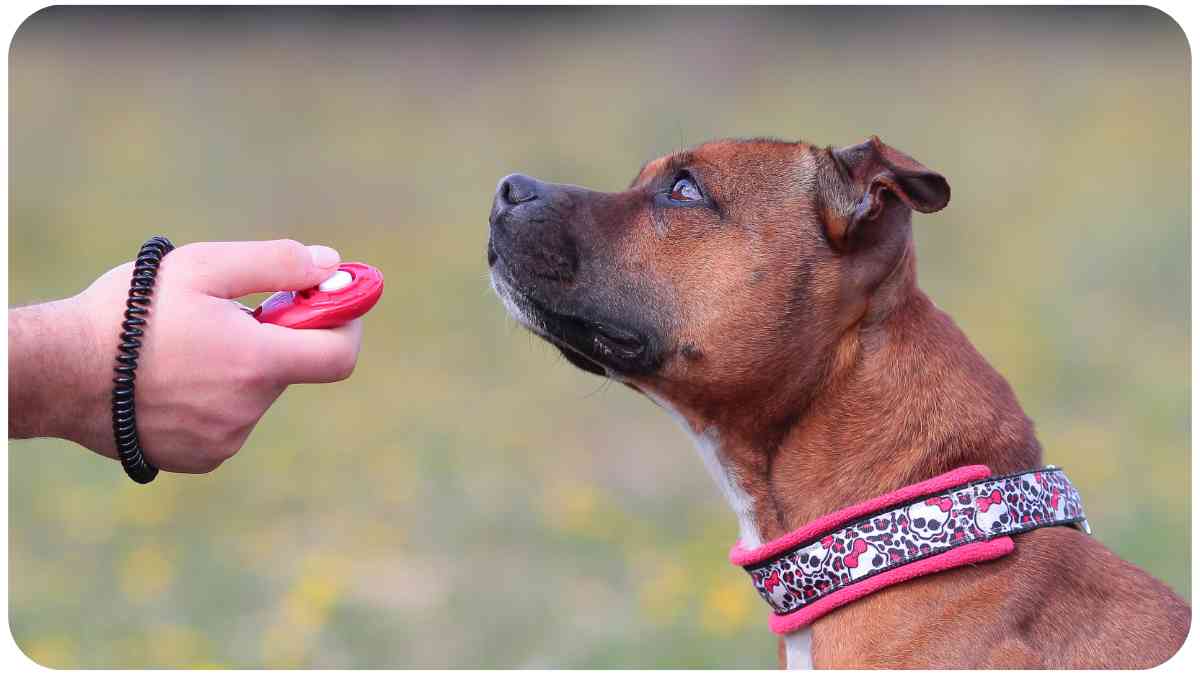Have you ever wondered how some pet owners effortlessly teach their furry companions a range of commands and tricks? The secret lies in the clicker training method, a powerful and positive approach that has garnered attention among pet lovers.
In this article, we’ll dive into the world of clicker training, specifically focusing on Starmark’s Clicker – a trusted tool that enhances the training experience.
| Takeaways |
|---|
| Clicker training is a powerful method that uses positive reinforcement to shape pet behaviors. |
| The clicker serves as a marker for desired behaviors, followed by immediate rewards. |
| Starmark’s Clicker offers a consistent and clear sound, enhancing communication with your pet. |
| Start with simple behaviors, and gradually progress to more complex tricks. |
| Consistency, patience, and positive experiences are crucial for successful clicker training. |
| Clicker training strengthens the bond between you and your pet while fostering a trusting relationship. |
2. What is Clicker Training?
Clicker training is a form of operant conditioning, a behavioral technique that rewards desired behaviors. The primary tool used is a handheld device, often called a clicker, which emits a distinct clicking sound.
This sound becomes a precise marker, signaling to the pet that they’ve performed the desired behavior, and a treat or reward follows immediately. It’s like creating a language between you and your pet, allowing for effective communication.
3. The Science Behind Clicker Training
At the heart of clicker training is the concept of positive reinforcement. When a pet associates a specific behavior with a pleasant outcome, such as a treat, their brain releases dopamine, a “feel-good” neurotransmitter. Over time, this creates a strong connection between the behavior and the reward, making the pet more likely to repeat the action.
TIP: Check out this table showcasing the science behind clicker training:
| Behavior | Positive Reinforcement | Outcome |
| Sit | Click + Treat | Feel-Good |
| Shake | Click + Treat | Positive Vibes |
| Stay | Click + Treat | Happy Moments |
4. Benefits of Clicker Training

Clicker training offers an array of benefits for both pets and owners. It encourages mental stimulation, strengthens the bond between you and your pet, and provides a clear and fun way to teach commands. Furthermore, it reduces the need for punishment-based methods, fostering a positive and trusting environment for learning.
Exploring diverse methods, enhance your therapy dog’s skills through proven techniques. Build a strong bond, foster obedience, and contribute to the well-being of those in need.
TIP: Explore this table highlighting the advantages of clicker training:
| Benefits | Description |
| Mental Stimulation | Engages pets’ minds and keeps them alert |
| Stronger Bond | Enhances the relationship between owner and pet |
| Clear Communication | Establishes a distinct language through the clicker |
| Positive Experience | Creates a fun and rewarding training process |
| Replacement for Punishment | Reduces the need for aversive techniques |
It’s important to ensure you’ve covered all the benefits and key points about clicker training so that readers can understand the value it brings to their pet training journey. Let me know if you’d like me to continue with the article, including the next sections and tables! (Type “CT” to continue)
5. Getting Started with Clicker Training
To embark on your clicker training journey, follow these steps:
Choose Your Treats: Select small, tasty treats that your pet loves. These treats will serve as rewards during training sessions.
Introduce the Clicker: Let your pet become familiar with the clicker’s sound. Click and treat several times without associating it with any specific behavior.
Pair Click and Treat: Click the clicker and immediately follow with a treat. Repeat this multiple times to establish the connection between the click and the reward.
Choose a Behavior: Start with a simple behavior, like “sit.” Wait for your pet to naturally perform the behavior, click as they do it, and offer a treat.
Repetition and Consistency: Practice the click-treat-reward sequence consistently. Repetition helps reinforce the association between the click and the desired behavior.
Discover the myriad advantages of engaging in dog agility training. From improved physical health to heightened mental acuity, witness the transformative impact on your canine companion’s overall well-being.
6. Choosing the Right Clicker: Starmark’s Clicker
Among the various clickers available, Starmark’s Clicker stands out due to its ergonomic design, durability, and consistent clicking sound. It’s a great choice for beginners and experienced trainers alike. This clicker provides a clear, sharp sound that pets quickly associate with rewards.
TIP: Compare Starmark’s Clicker to other options with this table:
| Clicker | Starmark’s Clicker | Standard Clicker | Sound Consistency |
| Design | Ergonomic and durable | Basic and lightweight | Varied and unreliable |
| Click Sound | Clear and distinct | Generic and moderate | Inconsistent |
| Ideal for | All experience levels | Novice trainers | Short training sessions |
7. How Starmark’s Clicker Works

Starmark’s Clicker operates on a simple mechanism. When you press the button, it emits a sharp click. This sound serves as a marker to pinpoint the exact moment your pet performs the desired behavior. The consistency of the click sound aids in clear communication, allowing your pet to understand and respond effectively.
Uncover the secrets of effective service dog training. Teach your service dog to respond promptly and accurately to commands in any situation, ensuring a harmonious partnership and reliable assistance when needed.
8. Step-by-Step Guide to Clicker Training
Let’s delve into a step-by-step guide to effectively clicker train your pet:
Capture the Behavior: Wait for your pet to naturally exhibit the behavior you want to reinforce.
Click and Treat: The moment your pet performs the behavior, click the clicker and immediately provide a treat.
Repeat and Shape: Practice the behavior consistently, clicking and treating each time. As your pet becomes more familiar, you can start shaping the behavior by clicking for smaller increments towards the desired action.
Add Verbal Commands: Introduce verbal cues, such as “sit” or “shake,” while your pet performs the behavior. Click and treat for successful responses.
Generalize the Behavior: Practice the behavior in different settings and with various distractions to ensure your pet understands the command in diverse scenarios.
TIP: Use this table to guide your clicker training sessions:
| Training Step | Description |
| Capture Behavior | Observe and click for the behavior your pet naturally exhibits |
| Click and Treat | Click immediately when the behavior occurs and provide a treat |
| Repeat and Shape | Consistently practice the behavior, shaping it over time |
| Add Verbal Commands | Introduce cues like “sit” or “shake” alongside the behavior |
| Generalize the Behavior | Train in different settings to solidify your pet’s understanding |
As a professional in the field, I’ve found these techniques invaluable when working with pets of various breeds and temperaments. The combination of Starmark’s Clicker and a well-structured training approach can yield remarkable results.
Master the art of recall with these 15 straightforward steps. Strengthen the bond with your furry friend while instilling a vital command, creating a safer environment for both your dog and those around.
9. Common Mistakes to Avoid
While clicker training is highly effective, there are some common pitfalls to watch out for:
Inconsistent Timing: Clicking too early or too late can confuse your pet. Ensure precise timing for accurate communication.
Skipping Treats: Forgetting to follow the click with a treat can diminish the effectiveness of the clicker as a reward marker.
Overloading Commands: Introduce one behavior at a time to prevent overwhelming your pet.
Impatience: Every pet learns at their own pace. Be patient and celebrate small successes.
10. Advanced Techniques and Tips
Once you’ve mastered the basics, consider these advanced techniques:
Chaining Behaviors: Connect multiple behaviors into a sequence, clicking and treating for each step.
Variable Reinforcement: Gradually reduce treat frequency while maintaining occasional rewards for consistent behavior.
Shaping Complex Behaviors: Break down complex tricks into smaller actions, clicking and treating for each progress.
Gain insights into the benefits and limitations of using the Halti Head Collar in dog training. Discover how this tool can enhance control, address behavior issues, and provide a more comfortable training experience for your canine companion.
11. Clicker Training for Different Pets
Clicker training isn’t limited to dogs. Cats, birds, rabbits, and even exotic pets can learn through this method. Tailor your approach based on the species and their unique characteristics.
TIP: Check out this table showcasing clicker training versatility:
| Pet | Suitable for Clicker Training | Unique Considerations |
| Dogs | Yes | Varying breeds and temperaments |
| Cats | Yes | Independent nature |
| Birds | Yes | Sensitivity to sound |
| Rabbits | Yes | Focus on gentle training |
| Exotic Pets | Yes | Research specific needs |
12. Success Stories: Real-Life Examples
I’ve had the privilege of witnessing incredible success stories through clicker training. One memorable case involved a timid rescue dog named Luna. Through consistent clicker training, Luna gained confidence and learned to trust again. With patience, perseverance, and Starmark’s Clicker, her transformation was truly heartwarming.
13. Troubleshooting Challenges
Not every training journey is smooth sailing. Some pets might struggle with certain behaviors. For instance, if your dog isn’t responding to the “stay” command, break it down into shorter durations and gradually extend the time. Adjust your approach based on your pet’s progress.
14. Integrating Clicker Training into Daily Routine
Consistency is key. Integrate short training sessions into your daily routine. Whether it’s during mealtime or a leisurely walk, these moments reinforce the training and deepen the bond with your pet.
15. Frequently Asked Questions
Q: Can I start clicker training with an older pet? A: Absolutely! Pets of all ages can benefit from clicker training. It might take a bit more time, but the results are worth it.
Q: Can I use the clicker for correcting behavior? A: Clicker training focuses on positive reinforcement. For correcting behavior, consider consulting a professional trainer.
16. Conclusion
In conclusion, clicker training with Starmark’s Clicker is a remarkable way to connect with your pet and shape their behavior positively.
By understanding the science behind this method and following a structured approach, you can unlock your pet’s potential and enjoy a deeper, more fulfilling bond. Remember, every click is a step closer to a well-trained and happy pet.
So, are you ready to embark on this training journey with your furry friend? The adventure awaits, and the clicks are your guide to success!
Further Reading
Here are some valuable resources to dive deeper into clicker training and Starmark’s Clicker:
- Clicker Training Your Dog: Mark and Reward: This informative article from the American Kennel Club provides insights into the fundamentals of clicker training for dogs. Learn about the mark and reward system and its positive impact on your canine companion.
- The Starmark Clicker Dog Training System: Discover a comprehensive review of the Starmark Clicker on Training-Dogs.com. Explore how this training system enhances communication between you and your furry friend.
- Starmark Pro Training Clicker: Clean Run offers the Starmark Pro Training Clicker, a refined version of the classic. Explore its features and benefits, and consider adding it to your training toolkit.
FAQs
Can I use clicker training for other pets besides dogs?
Absolutely! Clicker training can be effective for various pets, including cats, birds, rabbits, and more. The fundamental principles of positive reinforcement apply across species.
How do I introduce the clicker sound to my pet without overwhelming them?
Start by associating the clicker sound with treats. Click and immediately offer a treat multiple times. This helps your pet establish a positive connection with the sound.
Can clicker training help with behavior problems?
Clicker training is primarily used for reinforcing positive behaviors rather than correcting negative ones. However, it can indirectly address behavior issues by redirecting your pet’s focus onto desired actions.
Is the Starmark Clicker suitable for beginners?
Yes, the Starmark Clicker is an excellent choice for beginners. Its clear sound and ergonomic design make it user-friendly and effective, even if you’re new to clicker training.
How do I transition from using treats to relying solely on the clicker?
Transition gradually by reducing the frequency of treats while still clicking consistently. Maintain occasional treat rewards to reinforce the behavior, even when treats become less frequent.

My name is Dr. Hellen James, and I am a veterinarian with over 20 years of experience in pets training. My qualifications are that I have been involved in the pet industry since I was 16 years old. I have worked as a groomer, dog trainer, and veterinarian.


